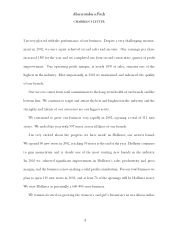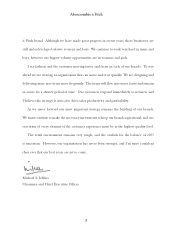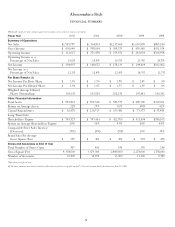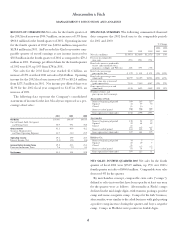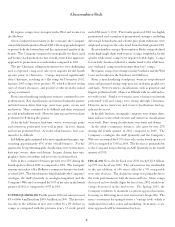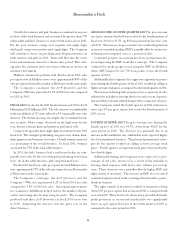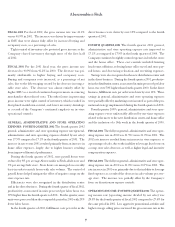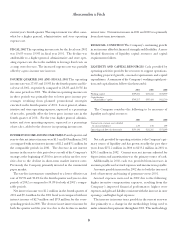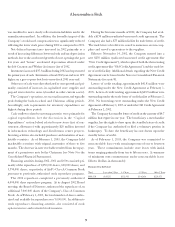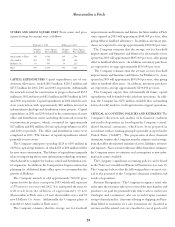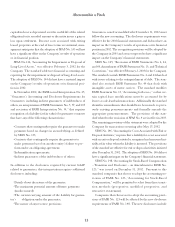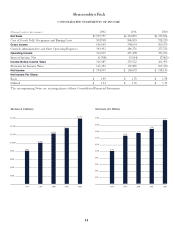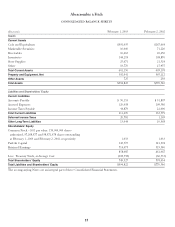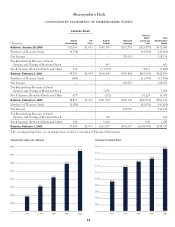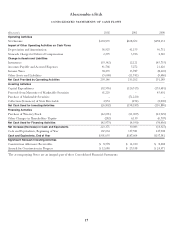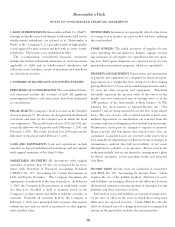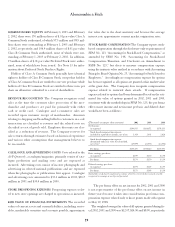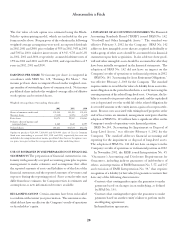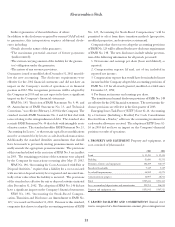Abercrombie & Fitch 2002 Annual Report Download - page 14
Download and view the complete annual report
Please find page 14 of the 2002 Abercrombie & Fitch annual report below. You can navigate through the pages in the report by either clicking on the pages listed below, or by using the keyword search tool below to find specific information within the annual report.
Abercrombie &Fitch
Employee discounts are classified as a reduction of revenue. The
Company reserves for sales returns through estimates based on his-
torical experience and various other assumptions that management
believes to be reasonable.
Inventory Valuation – Inventories are principally valued at the
lower of average cost or market, on a first-in first-out basis, utilizing
the retail method. The retail method of inventory valuation is an
averaging technique applied to different categories of inventory. At
A&F, the averaging is determined at the stock keeping unit (SKU)
level by averaging all costs for each SKU. An initial markup is
applied to inventory at cost in order to establish a cost-to-retail ratio.
Permanent markdowns, when taken, reduce both the retail and cost
components of inventory on hand so as to maintain the already
established cost–to-retail relationship. The use of the retail method
and the recording of markdowns effectively values inventory at the
lower of cost or market. The Company further reduces inventory
by recording an additional markdown reserve using the retail
carrying value of inventory from the season just passed.
Markdowns on this carryover inventory represent estimated
future anticipated selling price declines. Additionally, as part of
inventory valuation, an inventory shrinkage estimate is made
each period that reduces the value of inventory for lost or stolen
items. Inherent in the retail method calculation are certain sig-
nificant judgments and estimates including, among others, initial
markup, markdowns and shrinkage, which could significantly
impact the ending inventory valuation at cost as well as the result-
ing gross margins. Management believes that this inventory
valuation method provides a conservative inventory valuation as
it preserves the cost-to-retail relationship in ending inventory.
Property and Equipment – Depreciation and amortization of
property and equipment are computed for financial reporting pur-
poses on a straight-line basis, using service lives ranging principally
from 10-15 years for leasehold improvements and 3-10 years for
other property and equipment. Beneficial leaseholds represent the
present value of the excess of fair market rent over contractual rent
of existing stores at the 1988 purchase of the Abercrombie &
Fitch business by The Limited, Inc. (now known as Limited
Brands, Inc., “The Limited”) and are being amortized over the
lives of the related leases. The cost of assets sold or retired and the
related accumulated depreciation or amortization are removed
from the accounts with any resulting gain or loss included in net
income. Maintenance and repairs are charged to expense as
incurred. Major renewals and betterments that extend service
lives are capitalized. Long-lived assets are reviewed at the store
level at least annually for impairment or whenever events or
changes in circumstances indicate that full recoverability is ques-
tionable. Factors used in the evaluation include, but are not
limited to, management’s plans for future operations, recent
operating results and projected cash flows.
Income Taxes – Income taxes are calculated in accordance with
SFAS No. 109, "Accounting for Income Taxes,” which requires the
use of the liability method. Deferred tax assets and liabilities are
recognized based on the difference between the financial statement
carrying amounts of existing assets and liabilities and their respec-
tive tax bases. Inherent in the measurement of deferred balances
are certain judgments and interpretations of enacted tax law and
published guidance with respect to applicability to the Company’s
operations. Significant examples of this concept include capital-
ization policies for various tangible and intangible costs, income
and expense recognition and inventory valuation methods. No val-
uation allowance has been provided for deferred tax assets because
management believes the full amount of the net deferred tax assets
will be realized in the future. The effective tax rate utilized by the
Company reflects management’s judgment of the expected tax lia-
bilities within the various taxing jurisdictions.
RECENTLY ISSUED ACCOUNTING PRONOUNCEMENTS
The Financial Accounting Standards Board (“FASB”) issued
Statement of Financial Accounting Standards (“SFAS”) No. 142,
“Goodwill and Other Intangible Assets.” The standard was effec-
tive February 3, 2002 for the Company. SFAS No. 142 addresses
how intangible assets that are acquired individually or with a
group of other assets should be accounted for in financial state-
ments upon their acquisition. It also addresses how goodwill and
other intangible assets should be accounted for after they have been
initially recognized in the financial statements. The adoption of
SFAS No. 142 did not have an impact on the Company’s results
of operations or its financial position in 2002.
SFAS No. 143, “Accounting for Asset Retirement Obligations,”
was effective February 2, 2003 for the Company. The standard
requires entities to record the fair value of a liability for an asset
retirement obligation in the period in which it is a cost by increas-
ing the carrying amount of the related long-lived asset. Over time,
the liability is accreted to its present value each period, and the
11


